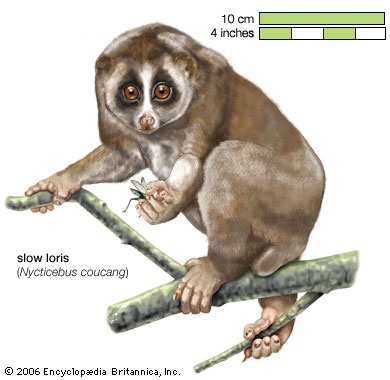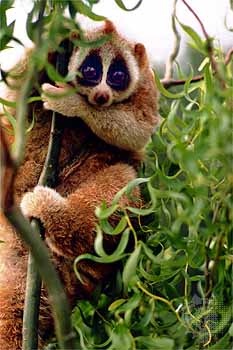loris
primate group
 any of about eight species of tailless or short-tailed South and Southeast Asian forest primates. Lorises are arboreal and nocturnal, curling up to sleep by day. They have soft gray or brown fur and can be recognized by their huge eyes encircled by dark patches and by their short index fingers. They move with great deliberation through the trees and often hang by their feet, with their hands free to grasp food or branches.
any of about eight species of tailless or short-tailed South and Southeast Asian forest primates. Lorises are arboreal and nocturnal, curling up to sleep by day. They have soft gray or brown fur and can be recognized by their huge eyes encircled by dark patches and by their short index fingers. They move with great deliberation through the trees and often hang by their feet, with their hands free to grasp food or branches.The slender loris (Loris tardigradus, now generally classified as two or more species) of India and Sri Lanka is about 20–25 cm (8–10 inches) long and has long, slender limbs, small hands, a rounded head, and a pointed muzzle. It feeds mostly on insects (predominantly ants) and is solitary. The female usually bears a single young after five or six months' gestation.
 The five slow lorises (genus Nycticebus) are more robust and have shorter, stouter limbs, more-rounded snouts, and smaller eyes and ears. They are found in Indonesia and on the Malay Peninsula. The smallest species (N. pygmaeus), restricted to forests east of the Mekong River, is about 25 cm long; the larger N. coucang and its relatives, widespread in Southeast Asia, are about 27–37 cm long. Slow lorises move more slowly than slender lorises; they feed on insects, small animals, fruit, and vegetation. The females bear one (sometimes two) young after about six months' gestation. Lorises are related to the pottos and angwantibos of Africa; together they constitute the family Lorisidae.
The five slow lorises (genus Nycticebus) are more robust and have shorter, stouter limbs, more-rounded snouts, and smaller eyes and ears. They are found in Indonesia and on the Malay Peninsula. The smallest species (N. pygmaeus), restricted to forests east of the Mekong River, is about 25 cm long; the larger N. coucang and its relatives, widespread in Southeast Asia, are about 27–37 cm long. Slow lorises move more slowly than slender lorises; they feed on insects, small animals, fruit, and vegetation. The females bear one (sometimes two) young after about six months' gestation. Lorises are related to the pottos and angwantibos of Africa; together they constitute the family Lorisidae.- Sevareid, Eric
- Sevastopol
- Sevastopol, Siege of
- Seve Ballesteros
- Seven Against Thebes
- Seven Cities of Cíbola
- Seven Days' Battles
- Seveners
- Seven, Group of
- Seven Hills of Rome
- Seven Holy Founders
- Sevenoaks
- Seven Oaks Massacre
- Seven Pines, Battle of
- Seven Sages of the Bamboo Grove
- Seven Sisters
- Seven Sleepers of Ephesus
- Seventeen Article Constitution
- seventeenth parallel
- Seventh-day Adventist
- Seven Weeks' War
- Seven Wise Masters
- Seven Wonders of the World
- Seven Years' War
- Severance, Caroline Maria Seymour